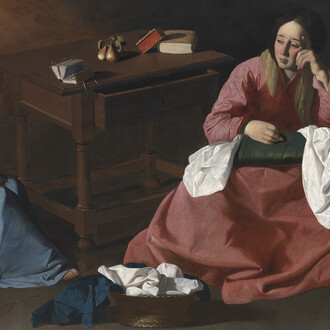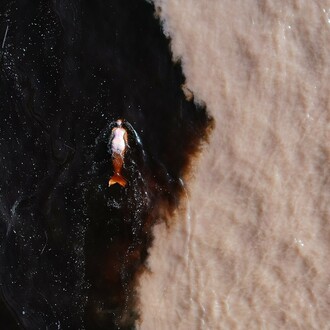David Zwirner is pleased to present Pennungal: lives of women and girls, an exhibition of new paintings by Indian artist Sosa Joseph, at the gallery’s London location. A masterful colourist and storyteller, Joseph creates atmospheric paintings marked by a striking visual and psychological complexity, in which figures from her South Indian family and milieu mingle with open-ended motifs from the natural world. Her work offers an alternative approach to the artistic tradition of history painting—one in which everyday moments take on the heft of the extraordinary and individual recollections coalesce into a richly tapestried communal history. This is the artist’s first solo presentation in Europe.
Begun in 2023, the body of work featured in Pennungal—a vernacular Malayalam term for “women”—is among Joseph’s most directly autobiographical. The paintings in this exhibition reflect on Joseph’s experiences and observations of the treatment of women and girls from her hometown of Parumala, an island village situated on the Pamba River in the South Indian state of Kerala, where the artist lived until the age of twenty-four. In her notable 2012 painting series What are we? (a major example of which is in the collection of The Metropolitan Museum of Art, New York), Joseph illustrated the lives of women from her current neighbourhood in Kochi. With this new body of work, the artist looks back at her formative early years, examining the societal and structural limitations that have long been imposed upon the women of her original hometown. In Parumala, Joseph recalls, “the entire upbringing of girls back then seemed to focus on ‘what not to become,’ with little emphasis on ‘what to become’”1.
Sweeping in scale and brimming with thoughtfully rendered detail, Joseph’s paintings are constructed from overlapping vignettes that draw the eye back and forth across the canvas, thereby visualising the meandering narrative intricacies of local folktales and other deep-rooted traditions of the shared and spoken word that arise in quotidian life. While Joseph paints largely from memory, sifting through her lived emotions and experiences, her works are deliberately open-ended in nature; they also invite viewers to participate in their own intensely personal exercise of interpretation and imagination.
Joseph begins each composition with a single vivid hue that she paints across the entire blank canvas. She then introduces the initial threads of figuration, approaching the painting process with an improvisatory and deeply introspective spirit; over time, figures, places, and palettes of evocative colour begin to materialise of their own accord. The artist works in many layers, wiping down the painting’s surface at regular intervals and reassessing the dreamlike, ephemeral images that are left behind. Joseph pursues these incidental leads as they come, seeking out personal pleasure through the act of painting. In the studio, she moves between four or five canvases at a time in a creative cycle that ebbs and flows, resulting in distinct scenes that are connected by an ever-changing throughline of physical and conceptual space.
The paintings in Pennungal run the true gamut of life in Parumala: sweet scenes of intergenerational trust and care—in which mothers teach their children, and daughters tend to their grandmothers and elders—are juxtaposed with the artist’s stark memories of the rigid patriarchal society that governed her early years and left lasting aftershocks of female isolation, shame, and desperation. As Joseph describes: “Not every one of these paintings has a specific story embedded in it. Many are simply compositions made by randomly fusing together recurring motifs from my girlhood. They’re pretty much improvisations from memory of moments, experiences, people, and so on. But they all relate to the lived experiences of women and girls as I knew them while growing up. That’s the only constant”2.
One work, Girl in the red blouse (2024), shows the titular scarlet-clad figure and her reflection in the river as a march processes in the distance. The image is based on Joseph’s memory of owning a shirt that was fashioned from red cloth intended to be sewn into Communist Party flags—the artist’s mother had pilfered the fabric from the Party’s stores, which were kept in Joseph’s house due to her father’s involvement as a senior party worker. In the large-scale painting Śarada (2023–2024), Joseph depicts a group of women washing the pale body of a pregnant girl who was found drowned in the Pamba River; a central kneeling figure cloaked in a red scarf represents her mother, who witnessed the scene firsthand as a teenager in the 1950s. In this work, the artist illustrates a familiar cautionary tale, passed down by generations of women around her, of the titular figure’s perceived moral transgression and impurity. “The important thing is,” remarks Joseph, “decades later, Śarada still lay there [as] a constant warning to all of us girls”3.
The river plays a similarly silent yet omnipresent role throughout the exhibition; in some works, it serves as a backdrop for domestic scenes that illustrate the subservient home lives many women in Parumala remain beholden to, in which even acts of pleasure are reduced to one of many tasks in a cyclical, chore-to-chore existence. Other paintings, such as Ammini, her two girls, and the river and Starry, starry night (both 2024), highlight the river’s abyssal turquoise form as a vessel for beauty, fecundity, fear, and, in dire moments, eternal escape. Mirroring the complexities of life itself, Joseph’s paintings oscillate between sobering reportage and intimate psychological reminiscence, revealing the binding network of mores, strictures, and rituals—both religious and secular—that so often define the contours of womanhood.
Sosa Joseph (b. 1971) was born in Parumala, Kerala, India. She studied painting at the Raja Ravi Varma College of Fine Arts, Kerala, and subsequently received a postgraduate diploma in painting from the Maharaja Sayajirao University of Baroda, Gujarat, India. Joseph lives and works between Kochi and Bangalore, India.
Recent solo exhibitions of Joseph’s work include The hushed history of oblivion, Stevenson, Cape Town (2023); and Where do we come from?, Galerie Mirchandani + Steinruecke, Mumbai (2022). Other one-person presentations include What are we?, Setouchi Triennale, Shodoshima, Japan (2016); Unspecified, Galerie Mirchandani + Steinruecke, Mumbai (2014); The common, Galerie Mirchandani + Steinruecke, Mumbai (2009); and Tenacity of the moon, Kashi Art Gallery, Kochi (2005).
Joseph’s work has been included in group exhibitions at museums and institutions worldwide, including Woman is as woman does, Jehangir Nicholson Art Foundation, Chhatrapati Shivaji Maharaj Vastu Sangrahalaya, Mumbai (2022); Art of India, Clarinda Carnegie Art Museum, Clarinda, Iowa (2021); Superposition: equilibrium and engagement, 21st Biennale of Sydney (2018); Mémoires des futurs | modernités indiennes, Centre Pompidou, Paris (2017); Mattancherry, URU Art Harbour, Kochi (2017); Kamarado, Stedelijk Museum Bureau Amsterdam (2015; travelled to Clark House Initiative, Mumbai, in 2016); 1st Kochi-Muziris Biennale, Kochi (2012); Panchatantra, Kashi Art Gallery, Kochi (2007); Intimate revelations, Schneider Museum of Art, Ashland, Oregon (2006); Open-eyed dreams, Durbar Hall Art Centre, Kochi (2006); and Remembering Bhupen, Kashi Art Gallery, Kochi (2003). In 2016, Joseph was granted a Setouchi Triennale Residency in Shodoshima, Japan, and in 2015 she participated in the Global Collaborations Program at the Stedelijk Museum Bureau Amsterdam.
In 2022, What are we? III, a major painting by Joseph that spans over three metres in length, was acquired by The Metropolitan Museum of Art, New York. Her work is also held in the collection of the Kiran Nadar Museum of Art, Delhi.
















